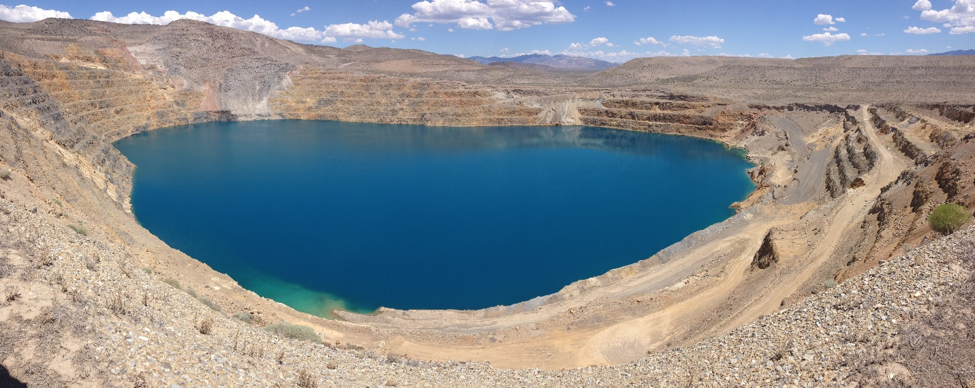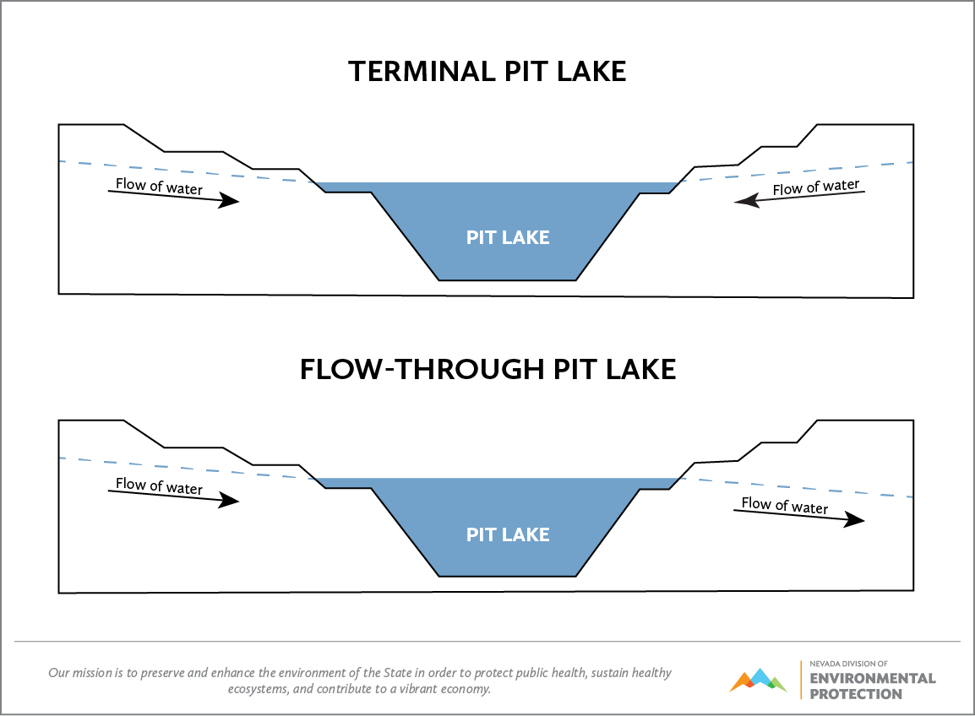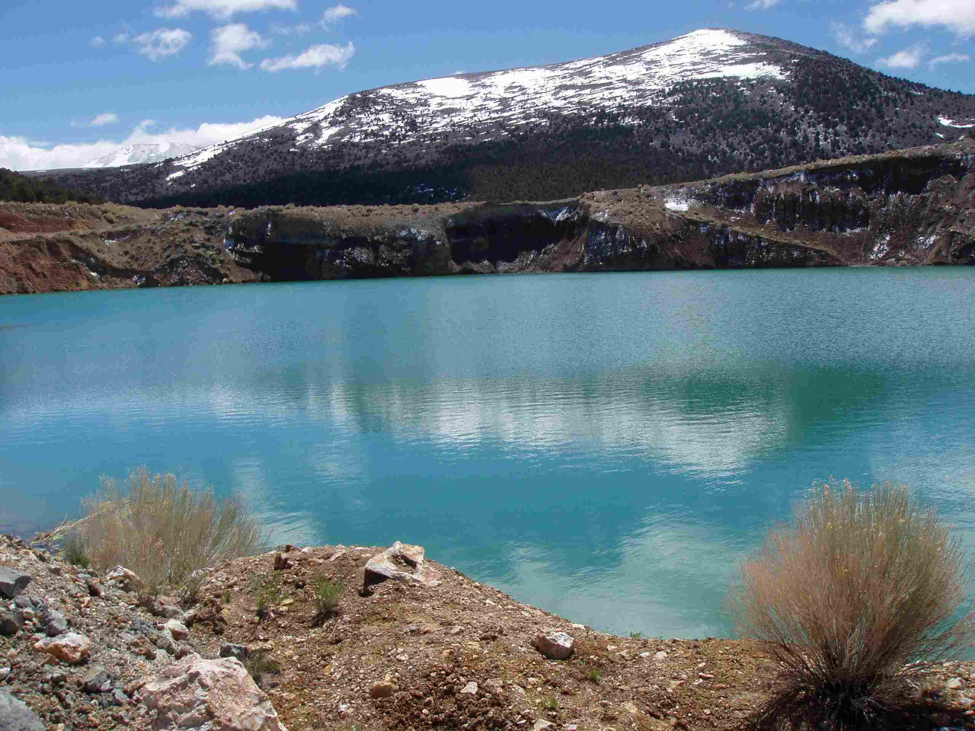Pit Lakes are Tricky to Manage: 4 Tools We Use to Preserve Water Quality

Pit lakes don’t form until years — even decades — after mining begins. So how can we be confident they won’t become toxic or harmful once water starts seeping back in? Rock samples, scientific models, and monitoring are key.
The pit lake in the photo above didn’t materialize overnight. When powerful pumps that kept the pit dry during mining fell silent, the groundwater returned without a dramatic entrance. It seeped in at a snail’s pace.
Water slowly but earnestly flowed in from the bottom up, inching up the fractured rock walls rimming the pit. Decades later, the water level finally stopped rising. And by then it had become hundreds of feet deep.
A mine pit — created after years of persistent blasting and digging — had become a pit lake. And like every other lake in Nevada, it is unique in its size, geology, and chemistry.
No two pit lakes are alike. Some are only a few acres, and others can be nearly a mile across. Some may rest in the wetter, eastern half of Nevada, while others receive mere inches of rain in the southern deserts. The rock around some may be rich in harmless minerals. Others may have elevated levels of salts and heavy metals.
This makes it tricky to write an environmental permit for mines that will create pit lakes. What will the water quality be like in 50 years? 200 hundred years? Will the fractured rock flush harmful minerals into the water? Could groundwater potentially be degraded as the water chemistry changes over time?
These questions are technically complex. The uniqueness of every mine site requires us to turn to solid data before we even approach an educated answer. But answering these questions is important to achieving our mission to protect Nevada’s environment.
Every time we review a mine plan, we start with four scientific tools to tell us whether a pit lake could violate Nevada’s water quality standards.
Rock characterization tests tell us if a pit lake could ever violate Nevada’s water quality standards — even decades into the future.
Tool #1: Rock characterization tests
Nevada’s rocks are rich in minerals and precious metals. It’s the main reason why mining companies are attracted to the Silver State. But the same mineralized rock can create a potential for pollution too: it may leach metals, acid rock drainage, or sediments into the water, characteristics we need to be aware of before permitting any mine.
To understand how a mine site may affect water quality in a pit lake, we look at the results of three tests that reveal key traits about the rock:
- Humidity cell tests bathe rock samples in water to speed up the aging process of rock. This shows the spectrum of minerals, chemicals, and metals that may leach out of the rock over time.
- A meteoric water mobility procedure gives us a picture of how rain and snow may release contaminants as they percolate through rock.
- Acid generation tests, also known as “acid-base accounting,” show the potential for acid to form – or be inhibited – through a combination of water, air, bacteria, and sulfur minerals.
What do these tests tell us?
On a scientific level, they help us predict the unique chemical profile of water years after it settles in a mine pit. But more importantly, they tell us if a pit lake could ever violate Nevada’s water quality standards or pose a risk to people or wildlife— even decades into the future.
With this information in hand, we are better equipped to decide what requirements to put in a permit so the mine operates without harming Nevada’s water resources.
Tool #2: Groundwater flow models
Groundwater doesn’t all move in the same direction: it bends, splits, sits still, speeds up, rises, and lowers — all depending on the geology of a given area. That means every pit lake interacts with groundwater differently.
Groundwater flow models enable us to peer beneath the surface to forecast, with reasonable confidence, how water will behave around a proposed mine site. Most importantly, they tell us how water is expected to act as it flushes back into a pit after mining stops, which affects the requirements we may put in a permit.
Nevada’s geology largely produces two types of pit lakes: flow-through and terminal.
Flow-through pit lakes directly interact with surrounding groundwater, which may flow in one wall and out another.
Terminal pit lakes, on the other hand, are surprisingly static. Decades after mining stops, the water level in a terminal pit lake stops rising. Rain, snow, and groundwater continue flowing in, but Nevada’s dry air causes water to evaporate just as quickly. Having reached equilibrium, the lake doesn’t mix with groundwater.

Groundwater flows into terminal pit lakes but not back out. In flow-through pit lakes, groundwater enters on one side and exits on the other, potentially carrying chemicals with it.
The type of pit lake matters when writing a mine permit. By law, a flow-through pit lake is not allowed to degrade the groundwater it interacts with, so we ensure it matches the quality of the surrounding water (See tool #3). A terminal pit lake, on the other hand, doesn’t blend with groundwater unless disturbed by pumping nearby. We gauge its water quality against the risk it poses to people and wildlife living in the area (See tool #4.)
Pit lakes can’t degrade groundwater — no component of a mine can — so we measure the quality of groundwater around every mine, setting a standard that must be upheld.
Tool #3: Groundwater quality tests
The quality of Nevada’s groundwater varies significantly from place to place. The water quality under one mountain range may be quite pure, comparable to the best mountain spring water. Under a range a few miles away, though, the water may be murky or brackish. It may have concerning levels of toxics like arsenic and selenium.
This variability makes site-specific data vital for upholding Nevada’s anti-degradation laws. By law, pit lakes can’t degrade groundwater — no component of a mine can — so we measure the quality of groundwater around every mine, setting a standard that must be upheld.
One to two years before mining begins, mines gather data from a system of NDEP-approved monitoring wells to find the natural — or “background” — quality of groundwater. This data becomes the standard in our permits that must be maintained in the pit lake, whether it’s through a treatment plant, by refilling the pit with rock and soil, or some other method.
The same monitoring wells also work to check for unexpected pollution and, if they do sense a problem, to let us know when and where to investigate.
Tool #4: Ecological risk assessments
Terminal pit lakes, far more common in Nevada’s arid climate, are a strange case. They are formed by groundwater but rarely mix with it, so they don’t fall under Nevada’s groundwater quality standards. They certainly look like lakes — though unusual for their steep walls — but they are lakes that didn’t exist before, so they lack designated uses like other water bodies that have existed for decades.
So what tools or standards do we use to make sure water in terminal pit lakes doesn’t pose a health risk to the public and wildlife? We require ecological risk assessments for mines that will create a pit lake that may pose an ecological risk.
Risk assessments can be quite involved, but the basic concept is simple:
- Toxicology models evaluate how trace chemicals in water may affect the health of local species — like owls, deer, or livestock — over time. Every species is different, with some animals being more sensitive to certain chemicals than others are.
- The results of the model are compared to our Profile III reference values — a list of chemicals like selenium, fluoride, and arsenic that may pose risks for wildlife at certain concentrations.
- If water in a pit lake will exceed values on the list — indicating a risk for harmful health effects in certain species — we write requirements in the mine permit to eliminate the risk.

Ecological risk assessments look at pathways by which animals might ingest pit lake water. This allows us to measure the risk trace chemicals in water may pose to wildlife.
Reducing risk looks different in every case. If models show only a few minor exceedances — mere parts per billion above a Profile III reference value — a requirement might be the construction of a fence around the pit to keep out the few bold animals that try to venture down the steep walls. Pit lakes with many exceedances or a high exceedance require more costly and involved methods, like treating the water so that birds can safely enjoy the lake during their yearly migrations.
Scientific Data, Front and Center
Pit lakes are geologically complex. Each interacts with air, climate, and minerals in the rock differently, making them undoubtedly tricky to manage. But by using the tools of science to get a clear picture of the dynamics of pit lakes, we are able to make fact-based decisions to protect Nevada’s water.
Data allows us to pinpoint the most strategic places for monitoring wells that sense contamination. It makes us aware of chemicals in the rock that could create problems for water quality.
Needless to say, we scrutinize a lot of data when reviewing a mine plan for a project that will create a pit lake. Statewide, we examine over 80,000 surface and groundwater data points every three months, in fact — more than half a million data points on mine characteristics every year.
It’s a lot to digest. But we do it because such careful science is what it takes to advance our mission to protect the environment from mining activities across Nevada.

Many pit lakes, including this one in Northern Nevada, have good water quality, attracting deer and birds to their shores. The water quality in some is good enough to support fish.
This blog is the third part of a series that casts light on how NDEP regulates mines. Public conversations on mining and the environment are happening every day in Nevada. Our goal is to support meaningful dialogue with reliable facts and information.
To learn more about Nevada’s program to protect the environment from mining, read part 1 and part 2 of this blog series or visit our website for detailed FAQs on specifics of Nevada’s mine regulations.
